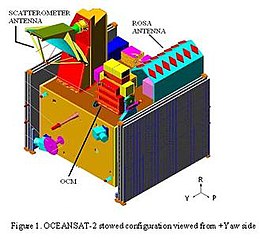Oceansat-2
 |
|
| Mission type | Oceanography |
|---|---|
| Operator | ISRO |
| COSPAR ID | 2009-051A |
| SATCAT no. | 35931 |
| Mission duration | 5 years planned |
| Spacecraft properties | |
| Bus | IRS |
| Launch mass | 960 kilograms (2,120 lb) |
| Start of mission | |
| Launch date | 23 September 2009, 06:21 UTC |
| Rocket | PSLV C14 |
| Launch site | Satish Dhawan FLP |
| Contractor | ISRO |
| Orbital parameters | |
| Reference system | Geocentric |
| Regime | Sun-synchronous |
| Perigee | 728 kilometres (452 mi) |
| Apogee | 731 kilometres (454 mi) |
| Inclination | 98.27 degrees |
| Period | 99.25 minutes |
| Epoch | 24 January 2015, 05:06:02 UTC |
Oceansat-2 is an Indian satellite designed to provide service continuity for operational users of the Ocean Colour Monitor (OCM)instrument on Oceansat-1. It will also enhance the potential of applications in other areas. The main objectives of OceanSat-2 are to study surface winds and ocean surface strata, observation of chlorophyll concentrations, monitoring of phytoplankton blooms, study of atmospheric aerosols and suspended sediments in the water.
Oceansat-2 is ISRO’s second in the series of Indian Remote Sensing satellites dedicated to ocean research, and will provide continuity to the applications of Oceansat-1 (launched in 1999). Oceansat-2 will carry three payloads including an Ocean Colour Monitor (OCM-2), similar to the device carried on Oceansat-1. Data from all instruments will be made available to the global scientific community after the post-launch sensor characterization, which is expected to be completed within 6 months of the launch. Oceansat-2 was launched from Satish Dhawan Space Centre on 23 September 2009 using PSLV-C14 .
The mission objectives of Oceansat-2 are to gather systematic data for oceanographic, coastal and atmospheric applications. The main objectives of OceanSat-2 are to study surface winds and ocean surface strata, observation of chlorophyll concentrations, monitoring of phytoplankton blooms, study of atmospheric aerosols and suspended sediments in the water.
Oceansat-2 will carry two payloads for ocean related studies, namely, Ocean Colour Monitor (OCM) and Ku-band Pencil Beam Scatterometer. An additional piggy-back payload called ROSA (Radio Occultation Sounder for Atmospheric studies) developed by the Italian Space Agency (ASI) is also proposed to be included. The major applications of data from Oceansat-2 are identification of potential fishing zones, sea state forecasting, coastal zone studies and inputs for weather forecasting and climatic studies.
The scientific payload contains three instruments. Two are Indian and one is from the Italian Space Agency.
...
Wikipedia
